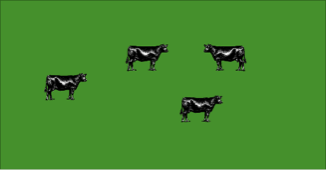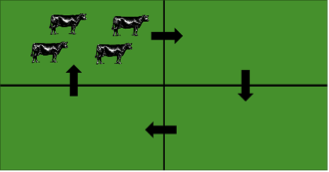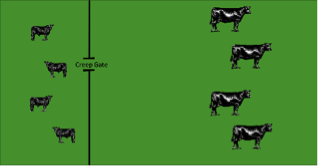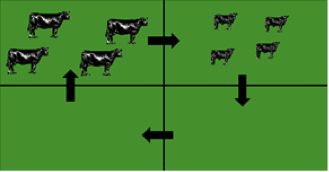Grazing Methods: Which One Is for You?

The flexibility of a grazing enterprise is what makes it appealing to many different managerial approaches. From the part-time farmer who has a few head of stocker calves during the growing season to keep the grass short, to the full-time producer who has a large cow-calf herd maintained year-in and year-out, grazing is often the preferred way to harvest forage. For these situations and all those in between, the implementation of different grazing systems can help producers meet their operation’s objectives while maintaining an optimum stocking density. Below are descriptions of popular grazing systems and the basic management involved.
Continuous Grazing – In this method, animals are allowed to have unrestricted, uninterrupted access to a specific unit of land throughout the entire or part of the grazing season. This is often referred to as the open gate method where all gates on the farm are open and cattle have access to every field. Continuous grazing can serve a role in livestock production where animals are encouraged to only eat the "cream of the crop". Generally, forage utilization is low and around 35%. Stocking density for the farm is not optimized. Another disadvantage is that manure nutrients are often concentrated in loafing areas and near water sources. Continually grazing the same plants and allowing animals to selectively graze can reduce stand persistence as targeted plants die from overgrazing. An example of continuous grazing is shown in Figure 1.

Rotational Grazing – The rotational grazing system is developed by subdividing a large pasture into two or more smaller paddocks and grazing these paddocks in a planned sequence. This provides rest periods for plants while others are being grazed. Once all the paddocks have been grazed, the sequence restarts with the first pasture that has been rested the longest being grazed. If done correctly, rotational grazing has many benefits including increased forage production, animal performance, and overall profitability. Rotational grazing allows plants to remain healthy by renewing energy reserves, rebuilding plant vigor, and giving long-term maximum production. Manure nutrients are more evenly distributed across the field as well. An example of rotational grazing is shown in Figure 2.

Strip Grazing – This technique involves utilizing a movable, electric fence to allot enough forage for a short time period and then moving the fence forward providing a new allocation of forage. Typically no back fencing is used in this method, and thus grazing should start in the area nearest to the water source to reduce waste due to trampling. Strip grazing can increase utilization and decrease animal selectivity. This method is often used when grazing stockpiled forages and annual forages. It can also be utilized during certain times of the year when grazing specific forage species like alfalfa in the late fall when resting the forage is not an issue. This method can be used in combination with rotational grazing. Fields can be strip grazed for example with dairy cows which are moved twice daily to be milked. Once grazed, cows are moved to the next field which is strip grazed while the previous area is rested. An example of Strip Grazing is shown in Figure 3.

Mob Grazing, also known as ultra-high density grazing – Mob grazing involves grazing a large concentration of livestock in a small area for a short duration. With stocking densities between 100,000 to 500,000 lbs or more of body weight per acre, animals are usually moved several times per day. Paddocks are only grazed 2 to 3 times per year. Long rest periods allow forages to become mature before grazing rather than being grazed in a vegetative state, allows for root systems to develop and energy stores to be built. This method forces livestock to graze everything available, rather than selecting only the lush forage. What is not grazed is trampled into the ground. Advocates claim this method will increase soil organic matter, reduce weeds, and increase manure distribution. Using this method, forage production and stand persistence may be reduced. Research into this method have yielded mixed results and long term effects on pastures have yet to be studied. This method requires increased labor and is best suited when grazing animals that have lower nutritional needs.

Creep Grazing – When using the creep grazing method, younger animals have access to a pasture of higher quality forage through a creep gate. This allows the young animals to graze the highly nutritious pasture and supplement their mother’s milk. This supplemental forage will increase gains in nursing calves and reduce the energy requirements for the cows. Often, the forage creep grazed (i.e. pearl millet, small grains or alfalfa) has a higher nutritive value than the common pasture. Only a small area is needed for the creep pasture along with a creep gate to control animal access. See Figure 4 for an example of Creep Grazing.
Forward Grazing or First-Last or Leader-Follower Grazing – This method consists of 2 groups of livestock on a paddock, one following directly after the other. This method is often used to graze animals with higher nutritional needs (i.e. growing calves) first to allow them to selectively graze the more nutritious forages in a paddock, followed by the group with lower nutritional needs to utilize the remaining forage (i.e. beef cows). This method can also be used when grazing two different species as well. An example of Forward Grazing can be seen in Figure 5.
Multi-species Grazing – In this method, different livestock species are grazed on the same pasture as one herd or using the forward grazing method. This can increase overall utilization and can be used to control weeds and other “undesirable” plants. Cattle, sheep, and goats prefer to graze different forage species and graze in different ways. When considering this method, an important factor to remember is that these species have different needs and may require increased labor, facilities and equipment.
Many types of grazing systems exist, and the benefits are abundant over using a continuous grazing system. Rotational grazing can drastically increase pasture utilization, production, forage quality, and stand persistence which can all increase animal health and performance. Labor, costs, time required, and possible benefits and detriments to the animals and pastures need to be considered when deciding if a technique will work on an operation. For more information on rotational grazing, see the UK publication Rotational Grazing.
References
Ball, D. M., C. S. Hoveland, and G. D. Lacefield. 2007. Southern Forages. 5th ed. International Plant Nutrition Institute. Norcross, GA.
Gerrish, J. R., C. A. Roberts. 1999. Missouri Grazing Manual. University of Missouri Board of Curators. Columbia, Mo.
Categories:
Winter
Grazing Systems


